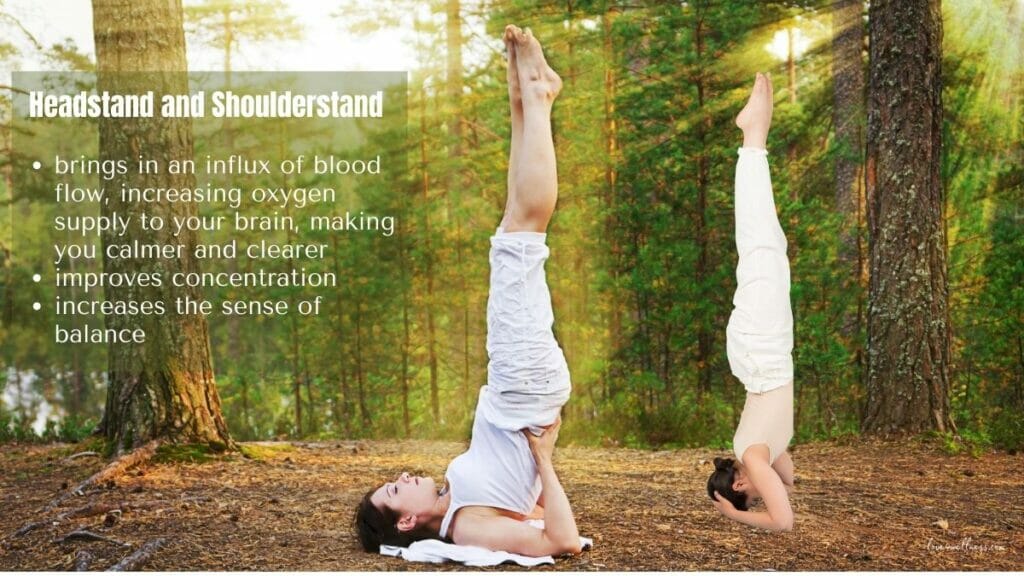Absolute beginner to yoga and fascinated by yoga inversion poses? Yet, you are afraid to practise them? You are not alone because yoga inversions are fascinating and equally intimidating not only for beginners but even for a pro. However, for the many benefits the yoga inversion poses offer, beginners must also do them. But how?
When we say inversions, the one pose that most people immediately visualise is the headstand or Sirsasana. Hence, many of you, particularly beginners, are threatened by inversions such as Sarvangasana and Sirsasana! But, don’t worry, yet; there are much easier inversion asanas that even a beginner can do.
This post is all about the yoga inversion poses, a brief account of the benefits, and a short video on easy inversion poses for beginners.
Yoga inversions are the poses or asanas where your heart and hips are above your head. Yoga inversions have profound physiological and psychological benefits on you and your body.
What happens when you do a yoga inversion pose?
Very simply, a few of your organs are upside-down for the time you stay in an inversion pose.
Does this help? Yes, in various ways. We will explain how.
Seven benefits you get from doing inversion asanas
1. Efficient functioning of the vein and lymphatic system:

Yoga inversions make your venous system and lymphatic system work effectively and with lesser effort.
Veins are the small blood vessels that carry deoxygenated blood and other metabolic wastes from tissues back to the heart. Likewise, the lymphatic vessels transport a fluid called lymph back to the heart.
Lymph is a clear fluid that washes away toxins such as bacteria and viruses from tissues and cells. The lymphatic system also produces lymphocytes (white blood cells) and releases them into the bloodstream.
Unlike arteries, veins and lymphatic vessels work under low pressure. The skeletal movement and muscular movement aids their flow, and the flow is often against gravity.
When blood flow through veins is staggered, venous pooling occurs, resulting in problems such as varicose veins. And a block in lymph nodes results in swelling and can reduce your body’s immunity.
Studies prove that staying in an inversion pose for just 3 to 5 minutes will enable wastes and fluids in the lower extremities of your body, such as the abdomen and pelvis, to drain efficiently into veins and lymph nodes. Further, the flow back to the heart is quicker than normal. So, beginners, inversion yoga is worth your effort!
2. Improved immunity:
The lymphatic system is a part of the immunity system. And effective functioning of the lymphatic system means improved immunity. Thus, practising yoga inversions has a positive effect on your body’s immune response.
3. Stimulate endocrine system:

Inversion poses such as Sarvangasana stimulates your endocrine system that houses thyroid and parathyroid glands. The glands secrete hormones vital for proper metabolism.
Practising shoulder stand helps menopausal and perimenopausal women as the hormonal imbalances are regulated very well. So, they experience reduced menopausal symptoms such as vaginal dryness, hot flashes, mood swings, and sleep disturbances.
4. More oxygen to your brain:

Yoga poses such as headstand and handstand enable an influx of oxygenated blood flow into your brain. If you ask people about their experience after a few minutes of headstand, “feeling calmer and clearer” would often be the response. Hence it is assumed, such an influx of blood flow invigorates your brain due to increased oxygen.
5. Improved balance and concentration:
Asanas, when done with a focus on your breath and movements, give you the desired effects. However, some asanas are simple and easy and so do not require much focus. Not with poses such as Sarvangasana or Sirsansana. Anyone would need increased focus, concentration, and a sense of balance to get into poses such as the Shoulderstand or Headstand.
So, as you keep practising such yoga inversion poses, your sense of balance increases, and so does your concentration.
6. Calm and restorative effects:

Asanas such as Balasana, Sarvangasana, and Legs-up-the-wall pose activates the parasympathetic nervous system, letting you calm and relax. The parasympathetic nervous system calms your sympathetic nervous system after a stressful situation has passed. And, when the parasympathetic nervous system is activated, your body rests, relaxes, and restores.
Try practising inversion asanas when in a stressful situation; your parasympathetic system is sure to help! A tip here; balasana and legs-up-the-wall are yoga inversions a beginner can quite well do.
7. Psychological benefits:
Are you feeling stressed and anxious? Balasana and Legs-up-the-wall pose are excellent calmers and hence do you a lot of good when under stress. Do these poses just before bedtime and enjoy a sound sleep.
Sarvangasana regulates hormonal imbalances; hence, it helps mood swings, depression, and anxiety associated with premenstrual, postpartum, perimenopausal, and menopausal women. Further, as mentioned above, increased concentration and focus improves your productivity, thus providing you with a sense of satisfaction and happiness. Thus, the calming inversion poses are just right for winding off a stressful day.
So, are you ready to get upside down?
Some easy yoga inversions for beginners
Now, you know what benefits you get from inversion asanas. Listed below are a few popular yoga inversions, and a few of them, beginners, can do as well.
- Forward fold (Beginner-friendly)
- Downward facing dog pose (Beginner-friendly)
- Headstand
- Shoulderstand
- Child’s pose (Beginner-friendly)
- Legs-up-the wall pose (Beginner-friendly)
- Dolphin pose (Beginner-friendly)
- Extended puppy pose (Beginner-friendly)
- Plough pose
- Crow pose
- Supported Shoulderstand (Beginner-friendly)
- Bridge pose (Beginner-friendly)
General advice while doing yoga:
Beginners, especially the younger lot who will also be the most enthusiastic, would want to try all yoga inversions. However, when you do yoga, you must always remember to take it slowly. Anything uncomfortable is not for you yet. Also, practice under the guidance of an expert.
Would you like to test yourself on Yoga and Pranayama?
Are yoga inversions for everyone?
No. Inversion asanas are not for everyone.
Many of us practise yoga as a therapy, and we might be having medical conditions. In that case, you must always do inversion asanas under expert guidance.
Specifically, beginners with heart disease, high blood pressure, head injuries, neck injuries, chronic neck pain, spinal problems, glaucoma, history of stroke, vertigo, inner ear problems, pregnancy beyond the first trimester, osteoporosis, and epilepsy should avoid yoga inversion poses.
Also, there are instances when things are not good, even for people who have been doing inversions for years. For example, due to various reasons, you might feel cervical pain when you do inversion poses.
In such a case, you must stop practising difficult poses such as Headstand and Shoulderstand. However, you can still get the benefits from easier poses such as Legs-up-the-wall and bridge pose.
Here is a short video with a compilation of yoga inversion poses/asanas easy enough for a beginner to do:
To conclude,
Yoga inversions provide a lot of awesome benefits both for your body and mind, and hence even beginners should practise them. As you can see, there are quite a few easy inversions, so why not do them and enjoy wellness?
So, go upside down, and reap the many benefits of yoga inversions. Be safe, though.
Images: canva.com

